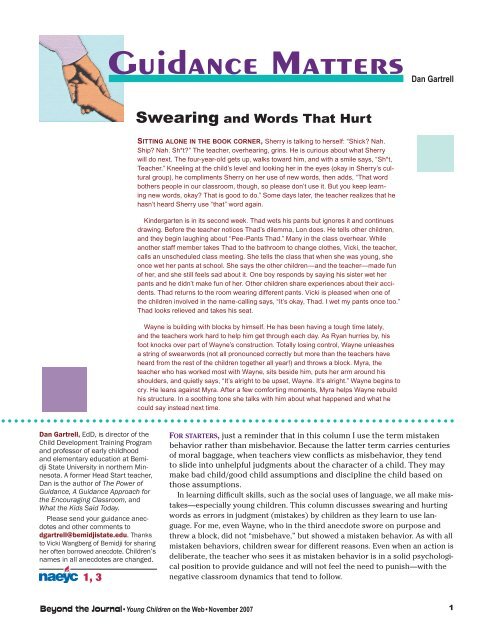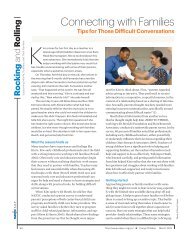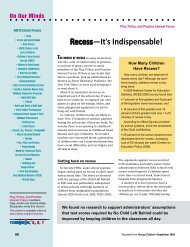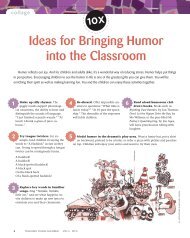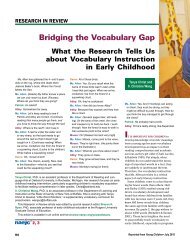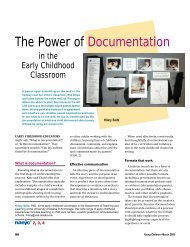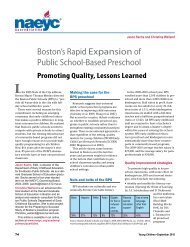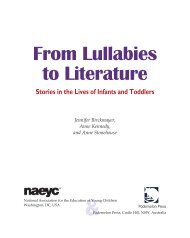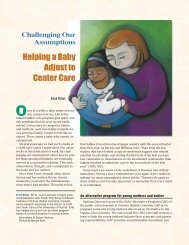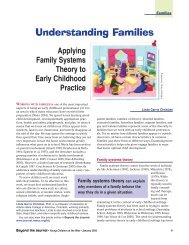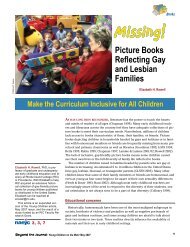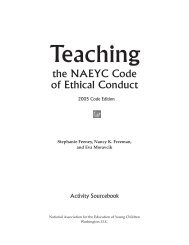Guidance Matters Dan Gartrell - National Association for the ...
Guidance Matters Dan Gartrell - National Association for the ...
Guidance Matters Dan Gartrell - National Association for the ...
You also want an ePaper? Increase the reach of your titles
YUMPU automatically turns print PDFs into web optimized ePapers that Google loves.
<strong>Dan</strong> <strong>Gartrell</strong>, EdD, is director of <strong>the</strong><br />
Child Development Training Program<br />
and professor of early childhood<br />
and elementary education at Bemidji<br />
State University in nor<strong>the</strong>rn Minnesota.<br />
A <strong>for</strong>mer Head Start teacher,<br />
<strong>Dan</strong> is <strong>the</strong> author of The Power of<br />
<strong>Guidance</strong>, A <strong>Guidance</strong> Approach <strong>for</strong><br />
<strong>the</strong> Encouraging Classroom, and<br />
What <strong>the</strong> Kids Said Today.<br />
Please send your guidance anecdotes<br />
and o<strong>the</strong>r comments to<br />
dgartrell@bemidjistate.edu. Thanks<br />
to Vicki Wangberg of Bemidji <strong>for</strong> sharing<br />
her often borrowed anecdote. Children’s<br />
names in all anecdotes are changed.<br />
1, 3<br />
<strong>Guidance</strong> <strong>Matters</strong> <strong>Dan</strong> <strong>Gartrell</strong><br />
Swearing and Words That Hurt<br />
Sitting alone in <strong>the</strong> book corner, Sherry is talking to herself: “Shick? Nah.<br />
Ship? Nah. Sh*t?” The teacher, overhearing, grins. He is curious about what Sherry<br />
will do next. The four-year-old gets up, walks toward him, and with a smile says, “Sh*t,<br />
Teacher.” Kneeling at <strong>the</strong> child’s level and looking her in <strong>the</strong> eyes (okay in Sherry’s cultural<br />
group), he compliments Sherry on her use of new words, <strong>the</strong>n adds, “That word<br />
bo<strong>the</strong>rs people in our classroom, though, so please don’t use it. But you keep learning<br />
new words, okay? That is good to do.” Some days later, <strong>the</strong> teacher realizes that he<br />
hasn’t heard Sherry use “that” word again.<br />
Kindergarten is in its second week. Thad wets his pants but ignores it and continues<br />
drawing. Be<strong>for</strong>e <strong>the</strong> teacher notices Thad’s dilemma, Lon does. He tells o<strong>the</strong>r children,<br />
and <strong>the</strong>y begin laughing about “Pee-Pants Thad.” Many in <strong>the</strong> class overhear. While<br />
ano<strong>the</strong>r staff member takes Thad to <strong>the</strong> bathroom to change clo<strong>the</strong>s, Vicki, <strong>the</strong> teacher,<br />
calls an unscheduled class meeting. She tells <strong>the</strong> class that when she was young, she<br />
once wet her pants at school. She says <strong>the</strong> o<strong>the</strong>r children—and <strong>the</strong> teacher—made fun<br />
of her, and she still feels sad about it. One boy responds by saying his sister wet her<br />
pants and he didn’t make fun of her. O<strong>the</strong>r children share experiences about <strong>the</strong>ir accidents.<br />
Thad returns to <strong>the</strong> room wearing different pants. Vicki is pleased when one of<br />
<strong>the</strong> children involved in <strong>the</strong> name-calling says, “It’s okay, Thad. I wet my pants once too.”<br />
Thad looks relieved and takes his seat.<br />
Wayne is building with blocks by himself. He has been having a tough time lately,<br />
and <strong>the</strong> teachers work hard to help him get through each day. As Ryan hurries by, his<br />
foot knocks over part of Wayne’s construction. Totally losing control, Wayne unleashes<br />
a string of swearwords (not all pronounced correctly but more than <strong>the</strong> teachers have<br />
heard from <strong>the</strong> rest of <strong>the</strong> children toge<strong>the</strong>r all year!) and throws a block. Myra, <strong>the</strong><br />
teacher who has worked most with Wayne, sits beside him, puts her arm around his<br />
shoulders, and quietly says, “It’s alright to be upset, Wayne. It’s alright.” Wayne begins to<br />
cry. He leans against Myra. After a few com<strong>for</strong>ting moments, Myra helps Wayne rebuild<br />
his structure. In a soothing tone she talks with him about what happened and what he<br />
could say instead next time.<br />
Beyond <strong>the</strong> Journal • Young Children on <strong>the</strong> Web • November 2007<br />
For starters, just a reminder that in this column I use <strong>the</strong> term mistaken<br />
behavior ra<strong>the</strong>r than misbehavior. Because <strong>the</strong> latter term carries centuries<br />
of moral baggage, when teachers view conflicts as misbehavior, <strong>the</strong>y tend<br />
to slide into unhelpful judgments about <strong>the</strong> character of a child. They may<br />
make bad child/good child assumptions and discipline <strong>the</strong> child based on<br />
those assumptions.<br />
In learning difficult skills, such as <strong>the</strong> social uses of language, we all make mistakes—especially<br />
young children. This column discusses swearing and hurting<br />
words as errors in judgment (mistakes) by children as <strong>the</strong>y learn to use language.<br />
For me, even Wayne, who in <strong>the</strong> third anecdote swore on purpose and<br />
threw a block, did not “misbehave,” but showed a mistaken behavior. As with all<br />
mistaken behaviors, children swear <strong>for</strong> different reasons. Even when an action is<br />
deliberate, <strong>the</strong> teacher who sees it as mistaken behavior is in a solid psychological<br />
position to provide guidance and will not feel <strong>the</strong> need to punish—with <strong>the</strong><br />
negative classroom dynamics that tend to follow.
Sherry: Experimentation<br />
Beyond <strong>the</strong> Journal • Young Children on <strong>the</strong> Web • November 2007<br />
Let’s face it, children often hear o<strong>the</strong>rs use expletives (swearing and o<strong>the</strong>r<br />
exclamations spoken in emotional circumstances). For many children, like<br />
Sherry, <strong>the</strong> reactions caused by <strong>the</strong>se words can be enticing.<br />
Trying new things, including new words, is what healthy four-year-olds are<br />
about. Writers from Montessori to Erikson to Gardner have been stating <strong>for</strong><br />
years that experimentation is how young children learn. Brain research tells<br />
us that optimal neural development occurs as children experience <strong>the</strong> intrigue<br />
of discovery without <strong>the</strong> stress of harsh evaluation (Shonkoff & Phillips 2000).<br />
When we withhold moral judgment, we have to admit that Sherry was engaged<br />
in a high-level, phonetic word-recognition activity! The challenge to teachers is<br />
that children’s experiments sometimes take us—and <strong>the</strong>m—in edgy directions.<br />
Sherry’s teacher saw her developmental need to experiment. He used a compliment<br />
sandwich to steer Sherry’s experimentation within <strong>the</strong> guidelines <strong>for</strong><br />
productive classroom behavior. The teacher knew that over-reaction might<br />
prompt a child to store certain words <strong>for</strong> use in “just <strong>the</strong> right” emotional situations.<br />
Sherry did not see <strong>the</strong> need to use <strong>the</strong> word again, a sign that <strong>the</strong> teacher<br />
successfully balanced guidance and support in his classroom.<br />
Thad: Socially influenced hurting words<br />
Children are like living sponges. They absorb in<strong>for</strong>mation from <strong>the</strong> world<br />
around <strong>the</strong>m and incorporate it into <strong>the</strong>ir growing beings. A child is socially<br />
influenced by adults and repeats in school words heard at home and in <strong>the</strong> community.<br />
Word experiments like “berry intelligent” make us smile without condition;<br />
a word like “sh*t,” as used by Sherry, may also make us smile, but that is<br />
probably not our only reaction.<br />
Classroom peers exert social influence on individuals, sometimes toward mistaken<br />
behaviors like a child starting a chant of “Pee-Pants Thad.” The leadership<br />
style of <strong>the</strong> teacher has much to do with whe<strong>the</strong>r socially influenced mistaken<br />
behavior becomes a pattern or remains just a sometime thing. When mistaken<br />
behavior involves many children, as in <strong>the</strong> second anecdote, it is time <strong>for</strong> a<br />
class meeting. Vicki’s meeting did what this <strong>for</strong>um does best: respectfully raises<br />
empathy levels and reminds <strong>the</strong> group that <strong>the</strong> classroom is to be encouraging<br />
<strong>for</strong> all.<br />
Class meetings sometimes involve complicated social dynamics, including <strong>the</strong><br />
issue of whe<strong>the</strong>r <strong>the</strong> child at <strong>the</strong> center of <strong>the</strong> situation should be present. In <strong>the</strong><br />
November 2006 issue of Young Children, <strong>Guidance</strong> <strong>Matters</strong> addresses some of<br />
<strong>the</strong>se issues in a column titled, “The Beauty of Class Meetings.”<br />
Wayne: Strong unmet needs<br />
When children experience frequent and severe conflicts over<br />
time, <strong>the</strong>y face problems that are bigger than <strong>the</strong>y are. For reasons<br />
of biology, life circumstances, or a mix of <strong>the</strong> two, <strong>the</strong>se<br />
children have deep unmet needs. Their behaviors are no less<br />
mistaken than those of children <strong>for</strong> whom survival is not an issue. The conflicts<br />
<strong>the</strong>y cause—often so challenging to adults—are attempts to ask <strong>for</strong> help. With<br />
his stress level high and his still-developing brain geared to fight or flight, Wayne<br />
could in no way say, “Ryan, it really bo<strong>the</strong>rs me that you knocked down part of<br />
my building.”
Copyright © 2007 by <strong>the</strong> <strong>National</strong> <strong>Association</strong> <strong>for</strong> <strong>the</strong><br />
Education of Young Children. See Permissions and<br />
Reprints online at<br />
www.journal.naeyc.org/about/permissions.asp.<br />
Beyond <strong>the</strong> Journal • Young Children on <strong>the</strong> Web • November 2007<br />
Wayne’s blue streak of swearwords was his way of protesting that<br />
his life was overwhelming and he had lost control. From her relationship<br />
with Wayne, Myra guessed <strong>the</strong> meaning of his behavior; she<br />
knew that <strong>the</strong> swearing was a symptom of <strong>the</strong> difficult challenges<br />
Wayne faced. At NAEYC’s 2007 <strong>National</strong> Institute <strong>for</strong> Early Childhood<br />
Professional Development in Pittsburgh, I shared this thought:<br />
Children who are challenging to adults are challenged by <strong>the</strong>ir own circumstances.<br />
The challenge <strong>for</strong> <strong>the</strong> teacher is to build a relationship with <strong>the</strong> child, work<br />
with fellow staff on a coordinated guidance plan, collaborate with family and o<strong>the</strong>r professionals<br />
to improve <strong>the</strong> situation, and, in short, rise to <strong>the</strong> challenge of <strong>the</strong> challenging<br />
behavior.<br />
For children like Wayne, swearing is an expression of unmet needs, not an<br />
indication of <strong>the</strong>ir character.<br />
There are many reasons children swear and use hurting words. When we see<br />
<strong>the</strong> use of expletives as a signal to learn about and work with a child, we are on<br />
<strong>the</strong> road to being caring professional teachers.<br />
To increase your knowledge<br />
Children use swearwords and hurting language in <strong>the</strong> overall process of language development.<br />
By understanding more about language development in general, <strong>the</strong> early childhood professional<br />
can listen to and interact with children to help <strong>the</strong>m develop communication skills that make <strong>the</strong><br />
“edgy words” unnecessary. Here are two articles you can read:<br />
Bailey, B., & C. Brookes. 2003. Thinking out loud: Development of private speech and <strong>the</strong> implications<br />
<strong>for</strong> school success and self-control. Young Children 58 (5): 46–52.<br />
Bailey and Brookes discuss <strong>the</strong> stages of development of private speech from infancy through<br />
age eight and provide teachers with in<strong>for</strong>mal methods of assessing which stage a child is in.<br />
Soundy, C., & N. Stout. 2002. Pillow talk: Fostering <strong>the</strong> emotional and language needs of young learners.<br />
Young Children 57 (2): 20–24.<br />
Meaningful verbal interactions are important to young children and support <strong>the</strong>ir language development.<br />
Soundy and Stout describe Pillow Talk, a nap-time ritual in which <strong>the</strong> teacher gives<br />
every child special one-on-one attention and acknowledges <strong>the</strong> child’s interests and experiences.<br />
Language is <strong>the</strong> foundation <strong>for</strong> all academic and social skills, and Pillow Talk teaches children<br />
that communicating with adults is interesting and rewarding.<br />
A step you can take<br />
Intentionally look <strong>for</strong> <strong>the</strong> occasions when a child uses expletives or hurting<br />
words. If you need to intervene, do so, but in a firm and friendly way that<br />
involves ei<strong>the</strong>r a guidance talk (perhaps with a compliment sandwich) or—if<br />
several children are involved—a class meeting. Brainstorm with colleagues<br />
why <strong>the</strong> child may have used <strong>the</strong> particular words. How might you use thoughts from this discussion<br />
as you continue to work with <strong>the</strong> child?<br />
References<br />
Shonkoff, J.P., & D.A. Phillips; eds. 2000. From neurons to neighborhoods: The science of early childhood<br />
development. A report of <strong>the</strong> <strong>National</strong> Research Council and <strong>the</strong> Institute of Medicine. Washington, DC:<br />
<strong>National</strong> Academies Press.


